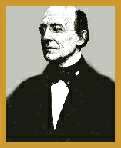| PinkMonkey Study Guide - American History
5. 2 The Anti-Slavery Movement
There was school segregation in the North. Beginning in 1830, the abolitionists and others tried to end it. They achieved a breakthrough in Boston in 1855, when the schools were desegregated. The Afro-American papers like North Star, Douglass’ Monthly, Freedom’s Journal and Rights for all (Seventeen such newspapers existed before the Civil War) contributed greatly to the work of the abolitionist movement and to a feeling of accomplishment on the part of blacks.
In the 1830s, a group in the north called the abolitionists
who were trying to help free slaves caused a great strain in the
relation between the northern and southern states. William Lloyd
Garrison’s ’Liberator’ was the mouthpiece of the abolitionists.
It called for the emancipation of slaves. This, along with Harriet
Beecher Stowe’s renowned work: Uncle Tom’s Cabin (1852) indicting
all slaves owners, put the southern states on the defense. The southern
states with their huge plantations existed on the sweat and toil
of the black slaves. The southerners defended slavery by arguing
that it was for the ’positive good’ of the blacks. They believed
that slave owners provided food, shelter and care to a race which
does not have the capacity to survive on their own in the modern
world.
The northerners with their industrial economy, looked at slavery as an impediment for growth of the economy, and a violation of the democratic ideal that the U.S. upheld. As the struggle against slavery grew and expanded, it was consolidated under one broad organization. The organization was called the American anti-slavery society founded in 1833. Garrison Weld, the Tappan brothers and the Grimke sisters all noted abolitionists were prominent members of the society. Under Weld’s direction, the society sent several petitions opposing slavery and urged the Congress to put an end to slave trade.
Though the anti-slavery had several internal differences, it gathered momentum. A group of abolitionists went on to form the Liberty Party in 1840 which took part in the elections.
The Abolitionist Movement
Black Americans from the north played a very important role in the abolitionist movement, which gradually created a mindset leading to a clash between the north and the south, and ultimately, achieved the abolition of slavery. When the abolitionist movement began its vigorous attacks on slavery in the 1830s, From among the white southerners arose such "Malcontents" as William Lloyd Garrison and Wendell Philips. They conveniently ignored the Afro-American abolitionists because discontentment on the part of Afro-Americans was contrary to their fundamental teachings. They did not want to change the slave system.

Exhibit 5.2
William Lloyd Garrison, one of the earliest abolitionists
and a key organizer of antislavery societies.
There were Afro-American conventions held annually in the north after 1830 to plan strategy and to make known black wishes regarding freedom equal rights. The abolitionists were not only concerned for the slave, they were also concerned with American freedom. They took pains to make it clear that they were not pressing for "Black rights" rather, they were pressing for a larger concept of American rights. They stressed that they were helping America to attain what it had projected for itself: a land of the free. Despite discrimination, the blacks worked for freedom through politics. They kept pressing for the vote in order to elect people who had abolitionist sentiments, people who would go to the state capital or to Washington to work against slavery.
One of the outstanding features of the antebellum black is that he tried to get suffrage despite the law and the constitution of his state. His interest in politics began formally with the Liberty Party (1840). Eight years later, he supported the formation of the Free Soil Party, which worked against the extension of slavery. He celebrated when the Republican Party came into existence in 1854, and supported it in 1856 and 1860. He realized that even if these parties did not stamp out slavery, they would not permit it to extend to the territories. This political interest on the part of black people, who themselves could not vote, was indeed commendable.
The Underground Railroad
Afro-Americans also worked in the Underground Railroad. The greatest of these underground operators was Harriet Tubman of Maryland. She worked hard and did not stop even when a price was put on her head. She helped thousands of blacks to escape to the Canada to become free. During the Civil War, she actively supported the northern states. While the war was on, she helped 300 people (blacks) to flee to the north. She even spied for the northern army.
[Next Page]
|